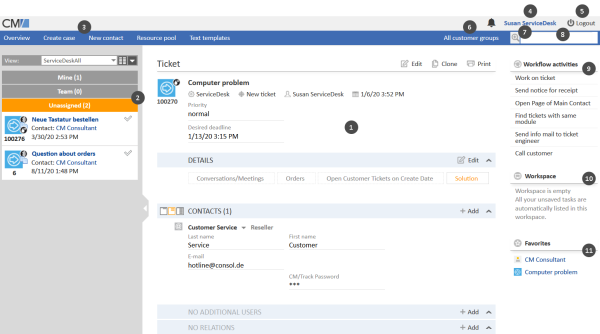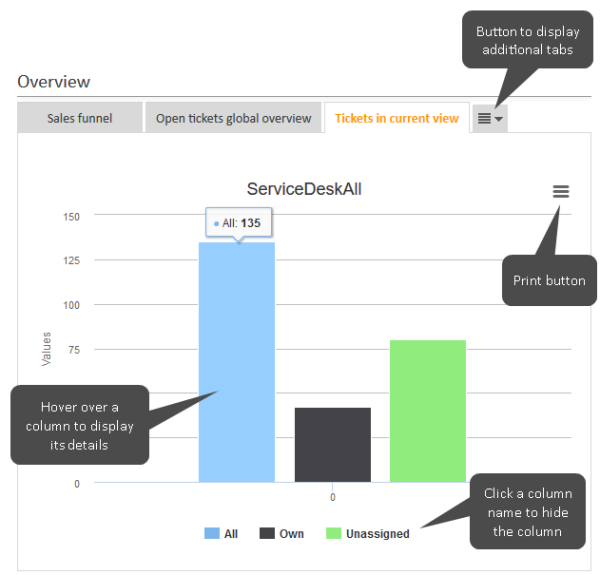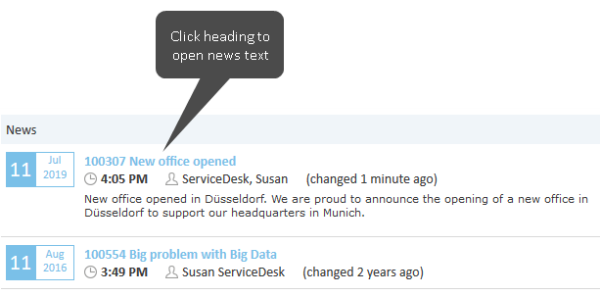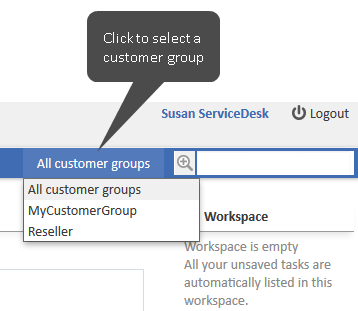Main features
Areas and functions
You will find the following areas and functions on the standard user interface of the ConSol CM Web Client:
Figure 8: The user interface of the ConSol CM Web Client
- Main working area (1)
The main working area displays the item which you are currently working on. This can be a case, a contact page, a resource page, a search results page, or a dashboard. The above example shows a case in the main working area. - Case list (2)
The case list provides you with a quick and convenient way to find cases (“to do list”). You can select a view above the case list.
Please see Case list for further information. - Main menu (3)
The main menu contains links to the different Web Client screens. Depending on the individual configuration of your CM system and your roles, you can see different menu items.
Please see Main menu for further information. - Link to the user profile (4)
The link to the user profile shows the name of the currently logged in user (here: Susan ServiceDesk). Click the name to open the user profile page, where you can adjust personal settings and set up representations.
Please see User profile for further information. - Logout button (5)
Click the Logout button to log out of the Web Client.
Please see Login and logout for further information about logging in to Web Client and logging out of the Web Client. - Customer group filter (6)
The customer group filter allows you to limit your work to a specific customer group, so you see only the contacts who belong to this customer group.
Please see Customer group filter for further information about this item. - Link to the Detailed Search (magnifying glass) (7)
Click the magnifying glass to open the Detailed Search page, where you can search for cases, contacts, and resources using multiple search criteria.
Please see Detailed Search for further information about the Detailed Search. - Quick Search (8)
The Quick Search allows you to search for cases, contacts, and resources without leaving the page you are currently working on.
Please see Quick Search for further information about the Quick Search. - Activities (9)
This section shows the available activities/actions for the item displayed in the main working area. These can be workflow activities for cases, contact activities for contacts, resource activities for resources, or search activities for Detailed Searches.
Please see Activities for further information. - Workspace (10)
The Workspace allows you to access temporarily saved data. If you create or edit case, contact, or resource data, and switch to another screen without saving, your latest draft is saved in the workspace. You can retrieve it later to continue working.
Please see Using the workspace for further information. - Favorites (11)
Favorites allow you to quickly access frequently used items. You can drag-and-drop cases, contacts, resources, or searches to the favorites, and open them with a single click afterwards.
Please see Using the favorites for further information.
Main menu
The main menu is displayed in the upper part of the screen, above the main working area.
The available menu items and their names depend on the individual configuration of your CM system.
The following items can be available:
- Overview
This menu item provides access to the dashboard. Please see Overview page for further information. - Create case
This menu item provides access to the Create case page, where you can create a new case. This menu item is displayed if you have permissions to create cases in at least one process. Please see Creating a case for further information. - Create contact
This menu item provides access to the Create contact page, where you can create a new company or person. This menu item is displayed if you have permissions to create contacts for at least one customer group. Please see Creating a contact for further information. - Resources
This menu item provides access to CM/Resource Pool. This menu item is displayed if CM/Resource Pool is active in your system and you have permissions to access resources. Please see Terms and definitions for further information. - Additional links (here: Reporting)
Your CM administrator can add additional links to the main menu. These are external links which depend on the individual configuration of your CM system.
Overview page
After logging in to the Web Client, you see the Overview page. It usually contains a dashboard showing a summary of the current cases. The dashboard consists of different widgets, which can be grouped in one or more tabs. The actual content and layout of the dashboard depend on the individual configuration of your CM system.
There are six types of standard widgets:
- Charts, e.g., column charts, pie charts, or funnel charts. A chart might contain interactive elements as shown in the following figure.
- Tables
- KPIs
- Recently visited: shows a list of items which the current user has recently visited
- Recent changes: shows a list of items which have been changed recently
- Calendar
- News
In addition, the dashboard can contain analysis wigets created with the add-on CM/EBIA.
The following example shows a dashboard consisting of one chart widget which displays a summary of the cases in the currently selected view. You can print the widget using the print button in the upper right corner of the widget. Hover over a column to display details about this column. You can hide columns by clicking the column name in the legend. To display it again, click the column name, which is grayed out.
Depending on the configuration of your CM system, other functionalities and types of widgets might be available.
Figure 9: Example of a dashboard on the Overview screen
The following example shows a news widget. Your CM system can provide news from different sources. Click the header of a news entry to display the news text.
Figure 10: Example of a news widget
The following example shows a Recent changes widget. The list can be filtered using the tool icon in the widget header. Click All actions to display all kind of changes, or User actions only to display only changes made by a user. You can click a link to open the page of the respective item. Click the show all link to open a pop-up window listing more items. The widget lists only changes to objects which the current user is allowed to see due to his permissions.
Figure 11: Example of a Recent changes widget
Customer group filter
Customer groups are used to manage different kinds of contacts within the same CM system. The customer group determines which contact data model is used for its contacts, i.e., which data fields are available and which relations and activities are possible for the contacts.
If you have access to more than one customer group, you can choose one of these customer groups in the customer group filter.
Figure 12: The customer group filter
Only the selected customer group will be shown on the user interface. This setting takes effect in the following areas:
- You can only create contacts in this customer group.
- You can only select contacts from this customer group in cases.
- The Quick Search is limited to the selected customer group, i.e., it shows only the results from the selected customer group.
- The Detailed Search is limited to the selected customer group, i.e., it does not offer the customer group as a search criterion anymore.




